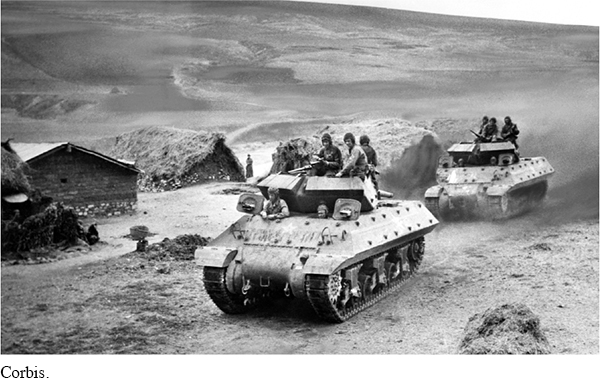The American Promise: Printed Page 726
The American Promise, Value Edition: Printed Page 662
The American Promise: A Concise History: Printed Page 754
The Campaign in Europe
After Pearl Harbor, Hitler’s eastern-
Until mid-
The most important strategic questions confronting the United States and its allies were when and where to open a second front against the Nazis. Stalin demanded that America and Britain mount an immediate and massive assault across the English Channel into western France to force Hitler to divert his armies from the eastern front and relieve the pressure on the Soviet Union. Churchill and Roosevelt instead delayed opening a second front, allowing the Germans and the Soviets to slug it out. This drawn-
The American Promise: Printed Page 726
The American Promise, Value Edition: Printed Page 662
The American Promise: A Concise History: Printed Page 754
Page 727In October and November 1942, British forces at El-

The American Promise: Printed Page 726
The American Promise, Value Edition: Printed Page 662
The American Promise: A Concise History: Printed Page 754
Page 728In January 1943, while the North African campaign was still under way, Roosevelt and Churchill met in Casablanca and announced that they would accept nothing less than the “unconditional surrender” of the Axis powers, ruling out peace negotiations. They concluded that they should capitalize on their success in North Africa and strike against Italy, consigning the Soviet Union to continue to bear the brunt of the Nazi war machine.
In July 1943, American and British forces landed in Sicily. Soon afterward, Mussolini was deposed in Italy, ending the reign of Italian fascism. Quickly, the Allies invaded the mainland, and the Italian government surrendered unconditionally. The Germans responded by rushing reinforcements to Italy, turning the Allies’ Italian campaign into a series of battles to liberate Italy from German occupation.
German troops dug into strong fortifications and fought to defend every inch of Italy’s rugged terrain. Allied forces continued to battle against stubborn German defenses for the remainder of the war, making the Italian campaign the war’s deadliest for American infantrymen. One soldier wrote that his buddies “died like butchered swine.”
REVIEW How did the United States seek to counter the Japanese in the Pacific and the Germans in Europe?